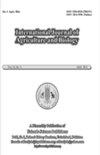气相色谱-质谱联用技术及其对玉米象中肠组织病理学的影响
Q2 Agricultural and Biological Sciences
引用次数: 0
摘要
本研究采用气相色谱-质谱法(GC-MS)测定了玉米象甲醇叶提取物中存在的植物化学物质及其对玉米象中肠组织学的影响。使用扩散法给昆虫施用10mg/kg的植物提取物,其中将昆虫放入含有不同浓度的培养皿中,观察它们由于毒性而开始死亡的阶段,并观察5分钟。将它们收集到箔处理纸中,并在Bouins液中固定24小时,24小时后重新包装,并在浸泡在缓冲福尔马林中的新鲜箔中折叠以进行组织病理学研究。结果显示,与对照组相比,呼吸道上皮层、分泌层细胞和胃肠道层的排列严重退化,肌肉层受到破坏。对狼毒甲醇叶提取物中的植物化学成分进行了初步筛选。提取物中含有强心苷、皂苷、甾体/萜类、黄酮类、生物碱和酚类。提取物的GC-MS分析显示存在2-硝基苯甲醛(4.00)、苹果酸(2.04)、L-天冬氨酸(2.00)、1,1、二甲基肼(1.86)、雪松二醇(1.75)、2-氨基-4-(2-甲基丙烯基)-嘧啶-5-羧酸(1.56)、硫烷(1.54)、巯基乙醇(1.11)和一些次要化合物。研究结果表明,狼毒甲醇提取物中含有丰富的对玉米中肠组织学具有生物活性的植物化合物。因此,建议将其作为农民用于保存储存谷物的合成杀虫剂的替代品。©2021 Friends Science出版社本文章由计算机程序翻译,如有差异,请以英文原文为准。
Gas Chromatography-Mass Spectroscopy and Histopathological Effects of Methanol Leaf Extract of Uvaria chamae on the Midgut of Sitophilus zeamais
The present study was carried out to assess the effect of methanol leaf extract of Uvaria chamae using Gas Chromatography-Mass Spectrum (GC-MS) to determine the phytochemicals present and its effect on the histology of midgut of maize weevil, Sitophilus zeamais. Insects were administered with 10 mg/kg of the plant extract using diffusion method where insects were put in a petri dish containing various concentrations and observed to see the stage they begin to die due to toxicity and observed for 5 min. They were collected into foil processing paper and fixed in Bouins fluid for 24 h, repacked after 24 h and folded in fresh foil immersed in buffered formalin for histopathological studies. Result revealed that a severe degeneration de-arrangement of the respiratory tract epithelial lining, secretory lining cells and gastrointestinal layers with the destruction of the muscular layer when compared with the control. The methanol leaf extracts of U. chamae were preliminary screened for the phytochemicals. The extract shows the presence of cardiac glycosides, saponin, steroids/terpenes, flavonoids, alkaloids and phenols. GC-MS analysis of the extract showed the presence of 2-nitrobenzaldehyde (4.00), malic acid (2.04), L-aspartic acid (2.00), 1, 1, dimethylhydrazine (1.86), Cedrandiol (1.75), 2-amino-4-(2-methylpropenyl)-pyrimidin-5-carboxylic acid (1.56), thiirane (1.54), mercaptoethanol (1.11) and some minor compounds. The findings indicated that methanol extract of U. chamae is rich in phyto-compounds having biological activities on the midguts’ histology of S. zeamais. Therefore, it is recommended as an alternative for the synthetic insecticide used by farmers for the preservation of stored grains. © 2021 Friends Science Publishers
求助全文
通过发布文献求助,成功后即可免费获取论文全文。
去求助
来源期刊

International Journal of Agriculture and Biology
AGRICULTURE, MULTIDISCIPLINARY-
CiteScore
1.70
自引率
0.00%
发文量
40
审稿时长
5 months
期刊介绍:
Information not localized
 求助内容:
求助内容: 应助结果提醒方式:
应助结果提醒方式:


